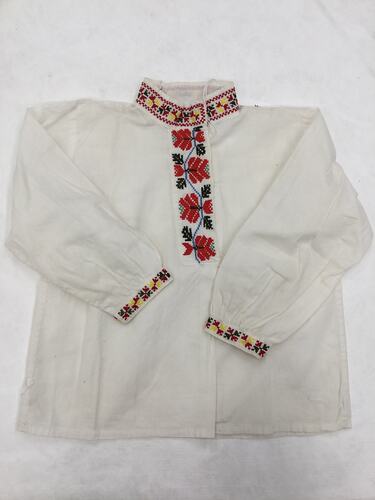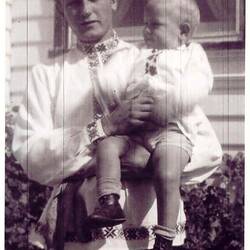Summary
Traditional Belarussian child's shirt, hand made and embroidered in Melbourne about 1953 by post World War II refugee from Belarus, Maria Basaranowicz. She made it for John Alexander Kazuro, around one year old at the time, the son of Marie and Alexander Kazuro. It was worn by him to represent the Belarussian community with his father in the multi-national parade to welcome Queen Elizabeth and Prince Phillip to Melbourne in 1954. His father Alexander who accompanied the boy wore a similar shirt.
Alexander had migrated to Australia with his parents Aleksandra and Dimitri Kazuro and his four siblings in 1949 (having survived the German occupation of Belarus, escaped Soviet invasion via an arduous journey, a Displaced Person's camp and three years in Belgium). The family settled in Reservoir in Melbourne's north and in 1956, one of the children, Mieczyslaw (Mick) was chosen to carry the Olympic torch along Collins Street and pass it to Australian athlete John Landy.This was a source of enormous pride for the Kazuro family and for the local Belarussian community.
Alex married Australian-born Marie (the donor) in 1952 and it was soon after their first child John was born that the shirt was made and he wore it (along with his father wearing a similar shirt) at the Royal Visit Parade in Melbourne in 1954.
Also in the collection are digital photographs showing Alex and John wearing their shirts for the parade.
Physical Description
White cotton, long-sleeved shirt with red, yellow, green and blue embroidered details around collar, down the front (geometric floral design) and around the cuffs.
Significance
This object provides a significant representation of traditional Belarussian life, cultural practices subsequently transported to Australia through migration and practised here as part of the preservation and maintenance of cultural life. It demonstrates the diversity across cultures within the context of the museum's regional costume collection. It is a precious migration object which has had a life in the transplanted context and has played a role in the activities of community organisations which have tried to maintain culture in increasingly challenging circumstances as subsequent generations have become further distant from the original migrating generation. The connection of the family story to two significant public events in Melbourne from the 1950s - the 1954 Royal Vist and the 1956 Olympic Games - further increases the social and cultural value of the story and related items.
More Information
-
Collecting Areas
Migration & Cultural Diversity, Home & Community, Childhood, Leisure, Public Life & Institutions, Clothing & Textiles
-
Made For
-
Maker
-
Owner
-
Classification
Migration, Settlement - cultural & social life, Social functions
-
Category
-
Discipline
-
Type of item
-
Keywords
Childhood, Children's Clothing, Children, Royal Visit to Australia, 1954, Handcrafts, Royal Visits

